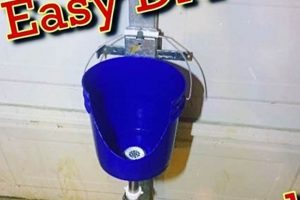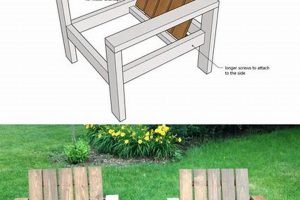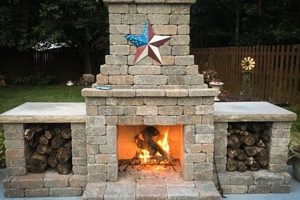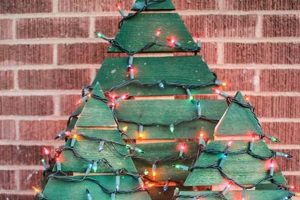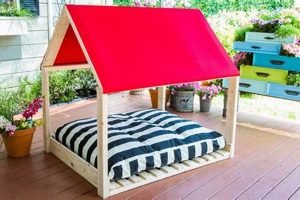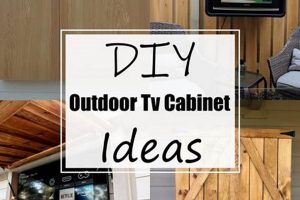A protective housing, often self-constructed, designed to shield a television set from the elements when placed in an exterior environment. These structures safeguard electronic components from rain, dust, extreme temperatures, and potential physical damage. One might build this type of protection to enjoy media content in spaces such as patios or decks.
The principal merit of such a construction lies in extending the lifespan of the television while enabling outdoor entertainment. Traditionally, outdoor television viewing was limited by weather conditions. The advent of weatherproofed encasements provides a durable barrier, ensuring consistent functionality and preventing costly repairs or replacements. The development of these custom builds mirrors the increasing demand for at-home entertainment solutions.
The subsequent sections will explore materials selection, construction methods, ventilation considerations, and power management strategies for creating a robust and effective outdoor television safeguard.
Construction Considerations for Exterior Television Protection
The following are crucial points to consider when constructing a housing for a television intended for outdoor use. Adherence to these guidelines enhances the structure’s durability and the television’s longevity.
Tip 1: Material Selection: Choose materials resistant to moisture, UV radiation, and temperature fluctuations. Treated lumber, marine-grade plywood, or aluminum are suitable choices due to their inherent weather-resistant properties. Improper material selection compromises the enclosure’s protective capabilities.
Tip 2: Ventilation is Paramount: Implement an adequate ventilation system. Overheating is a primary cause of electronic failure. Vents, potentially augmented by small fans, facilitate airflow, preventing the accumulation of heat within the enclosure.
Tip 3: Secure Mounting is Essential: Ensure the television is securely mounted within the enclosure. Vibration and movement from wind or other external factors can damage the screen and internal components. A robust mounting system minimizes this risk.
Tip 4: Weatherproof Sealing: Utilize weather-stripping and sealant to create a watertight barrier around doors, access panels, and other potential entry points for moisture. Pay particular attention to cable entry points.
Tip 5: Incorporate a Screen Protector: A clear acrylic or polycarbonate screen protector provides an additional layer of defense against impacts and scratches. This is especially important in environments where the television is exposed to potential physical hazards.
Tip 6: Consider a Thermostat-Controlled Heater: In colder climates, integrate a small thermostat-controlled heater to prevent the television’s internal components from freezing. Maintaining a stable temperature extends the television’s operational life.
Tip 7: Power Surge Protection: Install a surge protector inside the enclosure to safeguard against electrical surges caused by lightning or power fluctuations. Outdoor environments are more susceptible to these events.
Proper material selection, adequate ventilation, secure mounting, and robust weatherproofing are essential for ensuring the effective protection of an outdoor television. These considerations contribute significantly to the equipment’s long-term performance and reliability.
The subsequent section will discuss aesthetic design considerations and methods for integrating the enclosure seamlessly into the outdoor environment.
1. Weatherproof Materials
The selection of weatherproof materials constitutes a foundational element in the successful creation of any exterior television housing. The effectiveness of such a build, its longevity, and its ability to protect sensitive electronic components from the elements are all directly contingent upon the appropriate choice of construction materials.
- Moisture Resistance
The primary imperative is resistance to moisture. Materials susceptible to water absorption, such as untreated wood, are unsuitable due to their propensity to warp, rot, and foster mold growth. Marine-grade plywood, high-density polyethylene (HDPE), and certain composite materials offer superior resistance to water penetration. The use of these materials mitigates the risk of electrical shorts and component failure resulting from water damage.
- UV Radiation Stability
Prolonged exposure to ultraviolet (UV) radiation degrades many materials, causing discoloration, embrittlement, and structural weakening. Plastics lacking UV inhibitors are particularly vulnerable. Materials such as aluminum, powder-coated metals, and UV-resistant polymers exhibit greater stability under prolonged sun exposure, maintaining their integrity and appearance over time. The incorporation of UV-resistant coatings further enhances protection.
- Temperature Tolerance
Outdoor environments subject materials to significant temperature fluctuations. Materials that expand and contract excessively with temperature changes can compromise the structural integrity of the enclosure and create gaps for moisture intrusion. Materials with low thermal expansion coefficients, such as certain metals and composites, are preferable. These materials minimize the risk of distortion and maintain a tight seal in varying temperature conditions.
- Corrosion Resistance
Metallic components, including fasteners and hinges, are susceptible to corrosion, especially in coastal environments. The use of stainless steel, aluminum, or corrosion-resistant coatings is essential to prevent rust and maintain the structural integrity of the enclosure. Regular inspection and maintenance of metallic parts further extend their lifespan.
The careful selection and application of materials exhibiting moisture resistance, UV radiation stability, temperature tolerance, and corrosion resistance are paramount in ensuring the durability and protective capabilities of a self-constructed outdoor television enclosure. The long-term performance and reliability of the television are directly linked to the quality and suitability of the materials used in its construction.
2. Adequate Ventilation
Effective ventilation constitutes a critical element in the design and construction of any protective housing for outdoor televisions. Insufficient airflow within the enclosure leads to a rapid accumulation of heat generated by the television’s internal components. This heat build-up can cause a cascade of detrimental effects, including decreased performance, premature component failure, and a significant reduction in the television’s overall lifespan. The lack of adequate ventilation essentially negates the protective benefits the enclosure aims to provide.
Consider a scenario where an enclosure is constructed from insulating materials without proper ventilation. During periods of direct sunlight or high ambient temperatures, the internal temperature can quickly exceed the television’s operational limits. The resulting thermal stress accelerates the degradation of capacitors, resistors, and other sensitive components. In extreme cases, overheating may trigger the television’s internal safety mechanisms, shutting it down completely. A practical example would involve integrating screened vents strategically positioned to promote convective airflow cool air entering from below and warm air exiting from above. In hotter climates, the integration of small, low-power fans can further enhance ventilation, actively drawing heat away from the television.
In summary, the incorporation of adequate ventilation is not merely an optional feature; it is a fundamental requirement for the long-term viability of a self-constructed outdoor television protection. Without it, the enclosure risks becoming a thermal trap, ultimately defeating its purpose. A comprehensive ventilation strategy, tailored to the specific climate and television model, is essential to ensure reliable performance and protect the investment in outdoor entertainment. This approach also contributes to minimizing potential safety hazards associated with overheating electrical equipment.
3. Secure Mounting
The secure mounting of a television within a self-constructed outdoor enclosure is paramount for ensuring both the device’s operational integrity and the safety of its surroundings. The enclosure itself acts as the primary protective barrier, but its effectiveness is intrinsically linked to how well the television is anchored within it.
- Vibration Mitigation
Outdoor environments expose structures to wind, seismic activity, and other sources of vibration. A poorly mounted television is susceptible to excessive movement, which can lead to damage of the screen, internal components, and mounting hardware itself. Implementing a robust mounting system, such as a heavy-duty wall mount bolted directly to the enclosure’s structural frame, minimizes vibration and reduces the risk of failure. The selection of appropriate vibration dampening materials further enhances stability.
- Weight Distribution and Support
Televisions, particularly larger models, possess considerable weight. An inadequate mounting system can result in stress fractures within the enclosure or complete detachment of the television. It is crucial to calculate the television’s weight and select a mounting solution with a sufficient load-bearing capacity. Even distribution of weight across multiple mounting points prevents localized stress and ensures long-term stability. An example would be using a VESA mount rated for significantly more weight than the television itself, with the mount securely fastened to reinforcing members within the enclosure’s frame.
- Environmental Factors and Corrosion
Outdoor installations are vulnerable to corrosion caused by moisture, salt spray, and temperature fluctuations. The mounting hardware must be constructed from materials resistant to these environmental factors. Stainless steel or powder-coated aluminum are suitable choices. Regularly inspecting and maintaining the mounting hardware is essential to prevent corrosion-related failures. Protecting mounting points with weather-resistant sealant can further prevent moisture ingress.
- Accessibility and Serviceability
While secure mounting is critical, the design should also allow for reasonable access to the television for servicing, maintenance, or replacement. A mounting system that allows for tilting, swiveling, or easy removal facilitates these activities without compromising the overall security and stability of the installation. Designing access panels into the enclosure further enhances serviceability.
Ultimately, the selection and implementation of a secure mounting strategy are fundamental to the successful construction of an outdoor television enclosure. Failure to adequately address this aspect can result in equipment damage, safety hazards, and a reduced lifespan for both the television and the enclosure itself. The mounting system must be viewed as an integral component of the overall protective design, not merely an afterthought.
4. Cable Management
Effective cable management is an indispensable element in the construction of any outdoor television housing. The haphazard arrangement of cables exposes them to environmental stressors, creates potential safety hazards, and detracts from the overall aesthetic appeal of the installation. Poorly managed cables are susceptible to damage from moisture, UV radiation, and physical stress, potentially leading to signal degradation or complete failure of the television system. Moreover, loose or tangled cables pose a tripping hazard and present an unorganized appearance. Consider a scenario where a homeowner installs a television on a patio, leaving the power cord, HDMI cables, and antenna connections exposed. Over time, sunlight degrades the cable insulation, causing it to crack and expose the internal wiring. Rainwater seeps into the damaged cable, creating a short circuit that damages the television and poses an electrical shock risk. Organized cable routing, weather-resistant conduits, and secure connection points mitigate these risks.
Practical application of cable management principles involves several key strategies. The use of weatherproof enclosures for connection points shields sensitive components from moisture and corrosion. Cable ties, zip ties, and cable sleeves bundle wires together, preventing tangling and reducing strain on individual cables. Conduits, such as PVC pipes or flexible tubing, protect cables from physical damage and UV radiation. Drip loops, which involve creating a downward bend in the cable before it enters the enclosure, prevent rainwater from flowing directly into the connection points. Labeling each cable with a durable tag facilitates easy identification and troubleshooting. Furthermore, planning the cable layout during the enclosure’s design phase ensures adequate space for routing and accessibility for future maintenance. Ignoring these practices results in a system that is both vulnerable and difficult to service.
In summary, proper cable management is not merely a cosmetic concern; it is a crucial component of a robust and reliable outdoor television system. It enhances safety, protects equipment from environmental damage, and streamlines maintenance. The implementation of organized cable routing, weather-resistant conduits, and secure connection points is essential for maximizing the lifespan and performance of the television. The challenges associated with outdoor installations necessitate a meticulous approach to cable management, recognizing its direct impact on the system’s overall integrity. Neglecting this aspect undermines the protective intent of the enclosure itself and exposes the entire installation to unnecessary risks.
5. Screen Protection
Screen protection is a critical consideration when constructing a housing for a television intended for outdoor use. The screen, being the most vulnerable component, necessitates specific measures to mitigate potential damage from environmental factors and physical impacts. The robustness of the screen protection directly influences the television’s longevity and viewing experience.
- Physical Impact Resistance
Outdoor environments present a higher risk of physical impacts from debris, falling objects, or accidental contact. Integrating a protective screen overlay, typically composed of acrylic or polycarbonate, provides a durable barrier against such impacts. This shield absorbs the force of impact, preventing damage to the delicate LCD or LED panel beneath. The thickness and material properties of the overlay directly determine its ability to withstand impacts of varying magnitudes. Consider, for example, a polycarbonate sheet with a thickness of 1/4 inch, which offers significant protection against common outdoor hazards, such as pebbles or small branches. Such an addition is not just about preventing breakage but also about maintaining the integrity of the viewing experience by avoiding scratches and blemishes.
- UV Radiation Shielding
Prolonged exposure to ultraviolet (UV) radiation can degrade the screen’s color accuracy and brightness over time. Incorporating a UV-resistant film or coating on the protective screen minimizes this degradation. This UV shielding prevents the yellowing or fading of the screen, preserving the quality of the displayed image. The effectiveness of UV shielding is measured by its ability to block specific wavelengths of UV light. A UV-resistant film that blocks 99% of UV rays offers superior protection compared to one that blocks only 50%. This feature is particularly important in regions with high levels of solar radiation, where unprotected screens are more susceptible to damage.
- Glare Reduction
Outdoor lighting conditions often result in glare, which significantly impairs visibility. Implementing an anti-glare coating or film on the protective screen diffuses reflected light, improving contrast and clarity. This enhances the viewing experience, especially during daylight hours. Anti-glare coatings work by scattering incident light, reducing the intensity of reflections. The effectiveness of the coating is measured by its haze value, with lower haze values indicating better glare reduction. Choosing a screen protector with an appropriate anti-glare coating is essential for maximizing visibility in bright outdoor environments.
- Weather Resistance
The protective screen also acts as a barrier against rain, dust, and other environmental elements. It prevents these substances from directly contacting the television screen, which can cause damage or reduce visibility. The seal between the protective screen and the enclosure must be watertight to prevent moisture intrusion. Weather-resistant materials, such as silicone gaskets or weather stripping, are used to create this seal. Regular inspection and maintenance of the seal are necessary to ensure its continued effectiveness. This aspect is crucial for maintaining the clarity and functionality of the screen in all weather conditions.
In essence, screen protection is not merely an optional addition but a fundamental requirement for a successful project. The integration of impact resistance, UV radiation shielding, glare reduction, and weather resistance significantly extends the lifespan and enhances the usability of the television. Each of these components contributes to a more robust and enjoyable outdoor viewing experience. The design of a screen enclosure must consider these facets to ensure it offers comprehensive protection against the rigors of the external environment.
6. Accessibility
Accessibility, in the context of a self-constructed outdoor television housing, refers to the ease with which the television and its internal components can be accessed for maintenance, repairs, adjustments, and replacements. A design that overlooks accessibility can lead to significant difficulties and increased costs when addressing common issues, such as cable replacement, component upgrades, or even simple cleaning. For example, an enclosure constructed with a permanently sealed front panel necessitates complete disassembly to access the television, potentially damaging the enclosure in the process. This lack of accessibility can transform minor repairs into complex and expensive undertakings.
The integration of accessible design principles into the initial construction phase significantly mitigates these challenges. Hinged access panels, removable back panels, and strategically placed access ports facilitate easy entry to critical components. Internal mounting systems that allow the television to slide out or tilt forward simplify maintenance procedures. Furthermore, clear labeling of cables and components within the enclosure streamlines troubleshooting and reduces the likelihood of errors during repairs. These design choices are not merely conveniences; they are essential for ensuring the long-term serviceability and usability of the outdoor television installation. For example, consider an enclosure designed with a removable rear panel held in place by corrosion-resistant fasteners. This allows technicians to easily access the television’s input/output ports and power connections without disturbing the front panel or the television’s mounting. This approach dramatically reduces the time and effort required for routine maintenance and upgrades.
In conclusion, accessibility should be regarded as a core design parameter in the construction of a housing for an outdoor television, alongside weatherproofing, security, and aesthetics. A design that prioritizes accessibility ensures the television remains a functional and maintainable asset over its lifespan. Failure to consider accessibility at the outset results in a costly and frustrating ownership experience. By incorporating accessible design elements, the longevity, utility, and value of the outdoor television installation are significantly enhanced, which is beneficial to the device in terms of its maintenance, repairs, or adjustment.
7. Aesthetic Integration
Aesthetic integration represents a critical component in the design and construction of a self-constructed outdoor television housing. Its significance lies in transforming a purely functional item into an element that harmonizes with and enhances its surrounding environment. The practical effect of successful aesthetic integration is an outdoor entertainment space that is visually appealing, cohesive, and contributes positively to the overall ambiance. Conversely, neglecting aesthetic considerations results in a structure that appears out of place, detracts from the visual harmony of the outdoor area, and potentially diminishes the enjoyment of the space. A prime example involves an enclosure built from raw, untreated lumber placed on a meticulously landscaped patio. The visual discord disrupts the sense of tranquility and sophistication.
The practical application of aesthetic integration principles requires careful consideration of several factors. Material selection should complement existing outdoor furniture, architectural styles, and landscaping features. Color palettes should be chosen to blend seamlessly with the surroundings or provide a subtle accent. Design elements, such as trim, molding, and decorative hardware, can be incorporated to enhance the enclosure’s visual appeal and create a sense of refinement. The size and scale of the enclosure should be proportional to the surrounding space to avoid overwhelming the area. The integration of lighting elements can enhance the enclosure’s aesthetic appeal and functionality, providing both ambient and task lighting. A real-world example is using reclaimed wood to construct an enclosure that aligns with a rustic aesthetic in a garden setting.
In summary, aesthetic integration is not a superficial concern but a fundamental aspect of the successful outdoor television build. Its consideration ensures the enclosure contributes positively to the visual environment, enhances the enjoyment of the outdoor space, and avoids detracting from the overall aesthetic harmony. Addressing challenges involves balancing functionality with visual appeal, considering budget constraints, and adapting designs to specific environmental contexts. The integration ensures that the housing for the television is not simply a protective box, but a visually pleasing part of its environment.
Frequently Asked Questions
The following addresses frequently encountered inquiries regarding the design, construction, and maintenance of self-constructed outdoor television protective housings.
Question 1: What constitutes the most suitable material for constructing an outdoor television enclosure, considering long-term durability and weather resistance?
Marine-grade plywood, aluminum, or certain high-density plastics offer superior resistance to moisture, UV radiation, and temperature fluctuations. The specific choice depends on budget and aesthetic preferences. Untreated wood is generally unsuitable due to its susceptibility to rot and warping.
Question 2: How does one ensure adequate ventilation within an outdoor television enclosure to prevent overheating and potential damage to the television?
Strategic placement of screened vents, ideally with a convective airflow design (cool air entering low, warm air exiting high), is critical. In warmer climates, small, low-power fans may be necessary to actively circulate air and maintain optimal operating temperatures.
Question 3: What are the essential steps to take in order to safeguard electrical connections and prevent water damage within an outdoor television enclosure?
The utilization of weatherproof connectors, cable glands, and sealed access panels is paramount. Applying a generous layer of silicone sealant around all entry points for wires and cables further minimizes the risk of moisture ingress. Drip loops should be incorporated into cable routing to prevent water from following the cable into the enclosure.
Question 4: What is the recommended method for securing a television within an outdoor enclosure to prevent damage from wind or other external forces?
A robust mounting system, such as a VESA-compliant mount securely bolted to the enclosure’s structural frame, is essential. The mount must be rated for significantly more weight than the television. Vibration-dampening materials can further minimize the risk of damage from movement.
Question 5: How can one minimize glare and optimize viewing quality on an outdoor television, particularly during daylight hours?
Applying an anti-glare film or coating to the protective screen is an effective strategy. The use of a television with a high brightness rating and a wide viewing angle further enhances visibility in bright outdoor conditions. The orientation of the television should also be considered to minimize direct sunlight on the screen.
Question 6: What are the key considerations for ensuring the long-term maintenance and serviceability of a self-constructed outdoor television enclosure?
Hinged access panels, removable rear panels, and strategically placed access ports are crucial. All components within the enclosure should be clearly labeled. Regular inspection for signs of water damage, corrosion, or insect infestation is essential. A maintenance schedule should be established to address any potential issues promptly.
These FAQs address common concerns regarding the design, construction, and maintenance for outdoor television enclosures. Proper planning, execution, and the use of suitable materials will aid in the longevity of the product.
The subsequent article will explore advanced features and customization options for outdoor television protection, including integrated sound systems and smart home automation.
Conclusion
This exploration of diy outdoor tv enclosure design and construction has highlighted critical considerations, ranging from material selection and ventilation to security and aesthetic integration. The successful creation of a protective housing demands a comprehensive understanding of environmental factors and a commitment to employing best practices. Failure to address these elements can lead to premature equipment failure and negate the investment.
The pursuit of outdoor entertainment requires diligent planning and execution. Adherence to the principles outlined in this document will contribute to a durable and reliable system, extending the lifespan of valuable electronic equipment and enhancing the enjoyment of outdoor living spaces. The ongoing maintenance of this system is paramount to ensuring continued protection.


